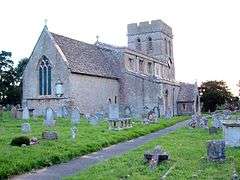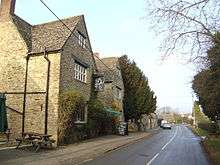Cumnor
| Cumnor | |
 St. Michael's parish church |
|
 Cumnor |
|
| Population | 5,503 (parish, 2001 census)[1] |
|---|---|
| OS grid reference | SP4604 |
| Civil parish | Cumnor |
| District | Vale of White Horse |
| Shire county | Oxfordshire |
| Region | South East |
| Country | England |
| Sovereign state | United Kingdom |
| Post town | Oxford |
| Postcode district | OX2 |
| Dialling code | 01865 |
| Police | Thames Valley |
| Fire | Oxfordshire |
| Ambulance | South Central |
| EU Parliament | South East England |
| UK Parliament | Oxford West and Abingdon |
|
|
Coordinates: 51°44′06″N 1°19′55″W / 51.735°N 1.332°W
Cumnor is a village and civil parish 3.5 miles (5.6 km) west of the centre of Oxford, England. The parish of Cumnor includes Cumnor Hill, (a ribbon development between Cumnor village and Botley), Chawley (at the top of Cumnor Hill), the Dean Court area on the edge of Botley and the outlying settlements of Chilswell, Farmoor, Filchampstead and Swinford. The parish was part of Berkshire until the 1974 local government boundary changes transferred it to Oxfordshire.
The village is about 2 miles (3.2 km) southwest of Botley and its centre is west of the A420 road to Swindon.
Amenities
Cumnor has two public houses, the Vine and the Bear and Ragged Staff. It also has a newsagent, a butcher, a hairdresser, a post office/greengrocery and a complementary health clinic. There are three churches: the Church of England parish church of Saint Michael in the centre of the village, Cumnor United Reformed Church in Leys Road and Living Stones Christian Fellowship that meets in the Primary School.

The village has football and cricket clubs, both located on Appleton Road.
Cumnor Primary School has produced many distinguished pupils who have attended schools such as Matthew Arnold School, Abingdon School, Magdalen College School, Oxford High School for Girls, Our Lady's Abingdon and the School of St Helen and St Katharine in Abingdon. The Oxford School of Music is based in Cumnor Hill.
Notable residents, as of October 2008, included novelist Philip Pullman[2] and celebrity chef Sophie Grigson.[3] The composer and conductor Christopher Whelen lived here for several years until his death in 1993.
Transport
There are a number of bus services that operate in Cumnor connecting Cumnor to Oxford City Centre and other local towns. Route X30 operates up to every 30 minutes during the day and provides links to Wantage and Oxford. Routes 4 and 4B also run every 30 minutes and link Cumnor with Abingdon and Oxford. There are also several infrequent services that serve Cumnor including route 63 to Southmoor and route 66 to Swindon.
History
Cumnor was first mentioned in 931 as Cumanoran. The name is of Old English origin, and appears to mean 'Hillside of a man named Cuma'.[4]
In Saxon and medieval times the parish was one of the largest in Berkshire, and included Wytham, Seacourt, North Hinksey, South Hinksey and Wootton.
In 1560 Cumnor Place was the scene of the death and suspected murder of Amy Robsart, the wife of Lord Robert Dudley. The house was pulled down in 1810,[5] because, it is said, her ghost gave the locals so much trouble.
Cumnor is the basis for Lumsdon in Thomas Hardy's novel Jude The Obscure.
Cumnor contains a number of houses by Clough Williams-Ellis, the architect most famous for his designs for Portmeirion. The Cumnor houses represent some of his earliest commissions, including his first commission, Larkbeare (1903-4, completed 1907) on Cumnor Hill, designed whilst he was still a student at the Architectural Association School of Architecture. The other examples are Cutts End House (1911, Appleton Road), Hurstcote (1922, Appleton Road), and Larkbeare Cottage (1910, Cumnor Hill; originally a gardener's cottage associated with Larkbeare). He also designed Cumnor Rise Hospital at a similar time to Larkbeare (designed 1903-4, completed 1907) but this was demolished in the 1990s.
See also
- Henry Brooke, Baron Brooke of Cumnor (1903–1984)
- Ruth Deech, Baroness Deech of Cumnor (born 1943)
- Cumnor Hurst
References
- ↑ "Area: Cumnor CP (Parish): Parish Headcounts". Neighbourhood Statistics. Office for National Statistics. Retrieved 23 March 2010.
- ↑ John Cornwell (24 October 2004). "Some enchanted author". Some enchanted author. The Times Online. Retrieved 6 January 2010.
- ↑ Sophie Grigson (1 March 2007). "Sophie's Guide to the World of Vegetables". The Oxford Times "Weekend". Retrieved 6 January 2010.
- ↑ Mills & Room, 2003, page not cited
- ↑ "Cumnor Place (Cumnor Hall) (Dudley Castle)". The DiCamillo Companion.
Sources & further reading
- Mills, A.D.; Room, A. (2003). A Dictionary of British Place-Names. Oxford: Oxford University Press. p. not stated. ISBN 0-19-852758-6.
- Page, W.H.; Ditchfield, P.H., eds. (1924). A History of the County of Berkshire, Volume 4. Victoria County History. pp. 398–405.
- Pevsner, Nikolaus (1966). Berkshire. The Buildings of England. Harmondsworth: Penguin Books. pp. 124–126.
External links
| Wikimedia Commons has media related to Cumnor. |
